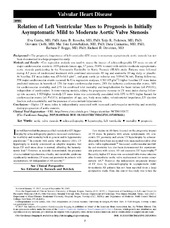| dc.description.abstract | Background—The prognostic importance of left ventricular (LV) mass in nonsevere asymptomatic aortic stenosis has not been documented in a large prospective study. Methods and Results—Cox regression analysis was used to assess the impact of echocardiographic LV mass on rate of major cardiovascular events in 1656 patients (mean age, 67 years; 39.6% women) with mild-to-moderate asymptomatic aortic stenosis participating in the Simvastatin Ezetimibe in Aortic Stenosis (SEAS) study. Patients were followed during 4.3 years of randomized treatment with combined simvastatin 40 mg and ezetimibe 10 mg daily or placebo. At baseline, LV mass index was 45.9+14.9 g/m2.7, and peak aortic jet velocity was 3.09+0.54 m/s. During follow-up, 558 major cardiovascular events occurred. In Cox regression analyses, 1 SD (15 g/m2.7) higher baseline LV mass index predicted increases in hazards of 12% for major cardiovascular events, 28% for ischemic cardiovascular events, 34% for cardiovascular mortality, and 23% for combined total mortality and hospitalization for heart failure (all P<0.01), independent of confounders. In time-varying models, taking the progressive increase in LV mass index during follow-up into account, 1 SD higher in-study LV mass index was consistently associated with 13% to 61% higher hazard for cardiovascular events (all P<0.01), independent of age, sex, body mass index, valvuloarterial impedance, LV ejection fraction and concentricity, and the presence of concomitant hypertension. Conclusions—Higher LV mass index is independently associated with increased cardiovascular morbidity and mortality during progression of aortic stenosis. | en_US |

